Nature vs. Nurture: Impact of Nature and Nurture on Offending Behavior
VerifiedAdded on 2021/02/21
|10
|2809
|130
Report
AI Summary
This report delves into the complex debate of nature versus nurture and its influence on offending behavior. It explores the definitions of nature, encompassing genetic and hereditary factors, and nurture, encompassing environmental factors like upbringing and social relationships. The report examines key variables associated with both nature (e.g., genital disorders, heredity) and nurture (e.g., community violence, growth environment) and their relationships to later offending. It uses statistical data to support these relationships, highlighting the impact of genetic predispositions and environmental influences. The report argues that while both nature and nurture play roles, nature, with its biological and hereditary components, has a slightly stronger influence on future offending. The report concludes with a discussion on the implications of these findings in understanding and addressing criminal behavior.

NATURE OR
NURTURE
NURTURE
Paraphrase This Document
Need a fresh take? Get an instant paraphrase of this document with our AI Paraphraser
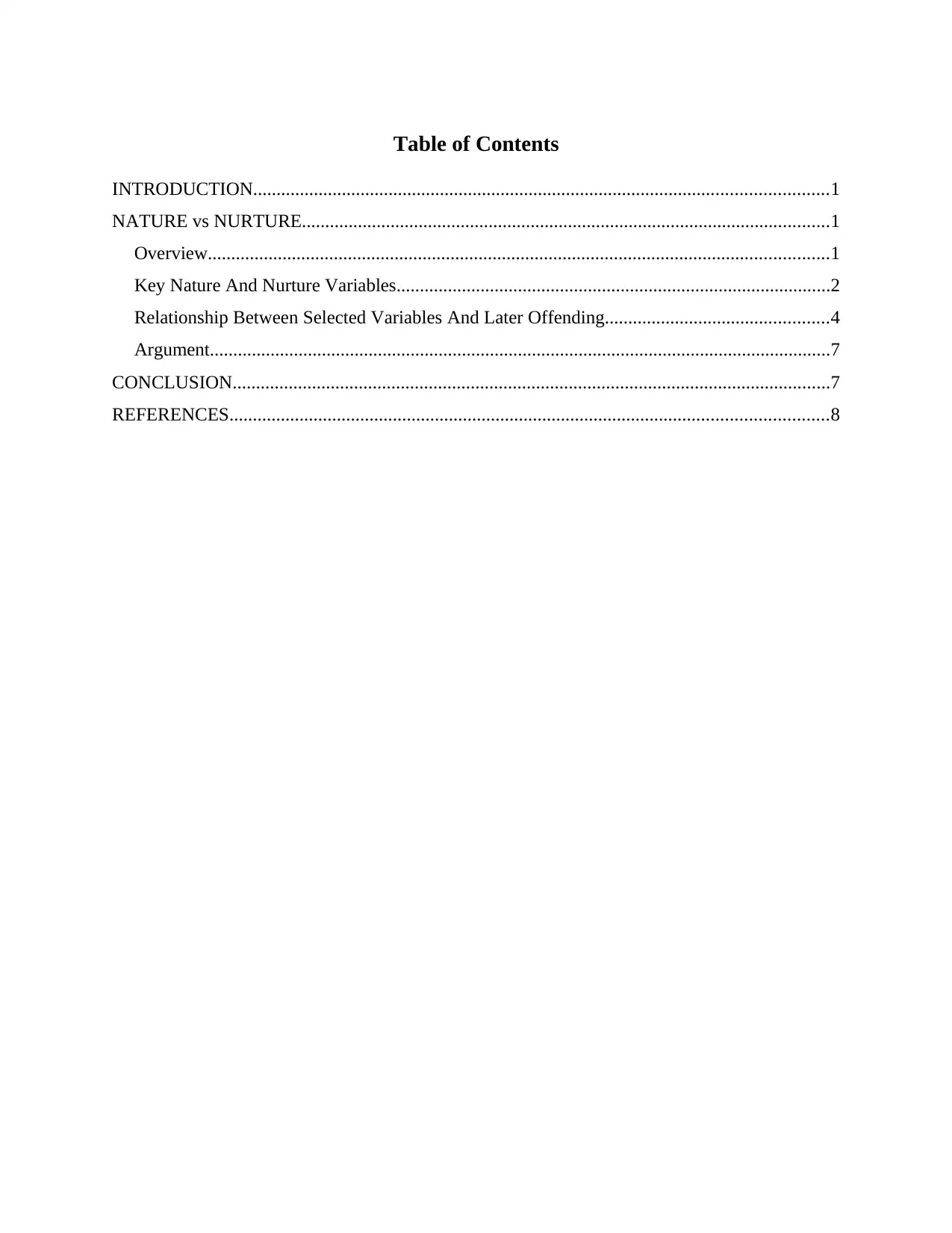
Table of Contents
INTRODUCTION...........................................................................................................................1
NATURE vs NURTURE.................................................................................................................1
Overview.....................................................................................................................................1
Key Nature And Nurture Variables.............................................................................................2
Relationship Between Selected Variables And Later Offending................................................4
Argument.....................................................................................................................................7
CONCLUSION................................................................................................................................7
REFERENCES................................................................................................................................8
INTRODUCTION...........................................................................................................................1
NATURE vs NURTURE.................................................................................................................1
Overview.....................................................................................................................................1
Key Nature And Nurture Variables.............................................................................................2
Relationship Between Selected Variables And Later Offending................................................4
Argument.....................................................................................................................................7
CONCLUSION................................................................................................................................7
REFERENCES................................................................................................................................8
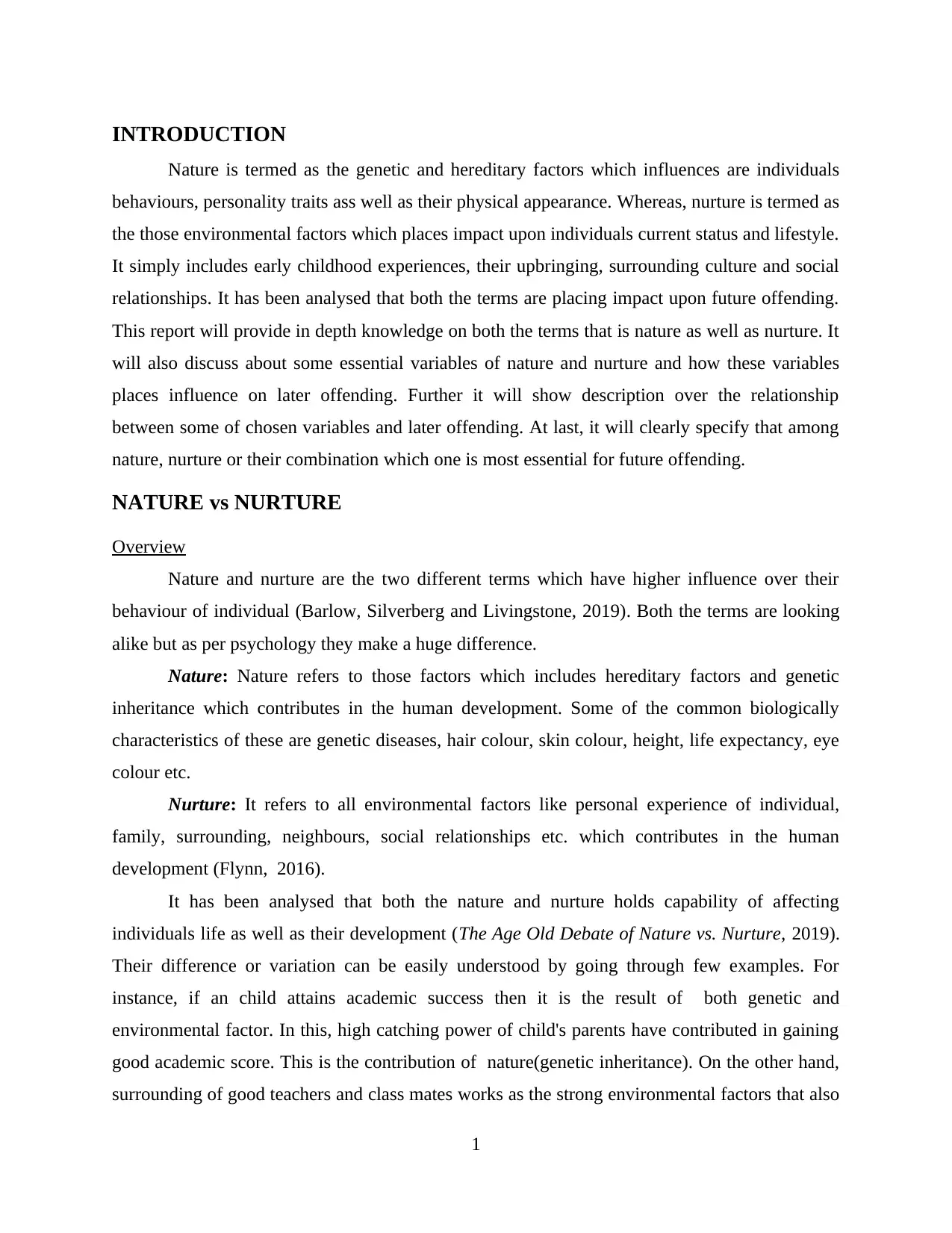
INTRODUCTION
Nature is termed as the genetic and hereditary factors which influences are individuals
behaviours, personality traits ass well as their physical appearance. Whereas, nurture is termed as
the those environmental factors which places impact upon individuals current status and lifestyle.
It simply includes early childhood experiences, their upbringing, surrounding culture and social
relationships. It has been analysed that both the terms are placing impact upon future offending.
This report will provide in depth knowledge on both the terms that is nature as well as nurture. It
will also discuss about some essential variables of nature and nurture and how these variables
places influence on later offending. Further it will show description over the relationship
between some of chosen variables and later offending. At last, it will clearly specify that among
nature, nurture or their combination which one is most essential for future offending.
NATURE vs NURTURE
Overview
Nature and nurture are the two different terms which have higher influence over their
behaviour of individual (Barlow, Silverberg and Livingstone, 2019). Both the terms are looking
alike but as per psychology they make a huge difference.
Nature: Nature refers to those factors which includes hereditary factors and genetic
inheritance which contributes in the human development. Some of the common biologically
characteristics of these are genetic diseases, hair colour, skin colour, height, life expectancy, eye
colour etc.
Nurture: It refers to all environmental factors like personal experience of individual,
family, surrounding, neighbours, social relationships etc. which contributes in the human
development (Flynn, 2016).
It has been analysed that both the nature and nurture holds capability of affecting
individuals life as well as their development (The Age Old Debate of Nature vs. Nurture, 2019).
Their difference or variation can be easily understood by going through few examples. For
instance, if an child attains academic success then it is the result of both genetic and
environmental factor. In this, high catching power of child's parents have contributed in gaining
good academic score. This is the contribution of nature(genetic inheritance). On the other hand,
surrounding of good teachers and class mates works as the strong environmental factors that also
1
Nature is termed as the genetic and hereditary factors which influences are individuals
behaviours, personality traits ass well as their physical appearance. Whereas, nurture is termed as
the those environmental factors which places impact upon individuals current status and lifestyle.
It simply includes early childhood experiences, their upbringing, surrounding culture and social
relationships. It has been analysed that both the terms are placing impact upon future offending.
This report will provide in depth knowledge on both the terms that is nature as well as nurture. It
will also discuss about some essential variables of nature and nurture and how these variables
places influence on later offending. Further it will show description over the relationship
between some of chosen variables and later offending. At last, it will clearly specify that among
nature, nurture or their combination which one is most essential for future offending.
NATURE vs NURTURE
Overview
Nature and nurture are the two different terms which have higher influence over their
behaviour of individual (Barlow, Silverberg and Livingstone, 2019). Both the terms are looking
alike but as per psychology they make a huge difference.
Nature: Nature refers to those factors which includes hereditary factors and genetic
inheritance which contributes in the human development. Some of the common biologically
characteristics of these are genetic diseases, hair colour, skin colour, height, life expectancy, eye
colour etc.
Nurture: It refers to all environmental factors like personal experience of individual,
family, surrounding, neighbours, social relationships etc. which contributes in the human
development (Flynn, 2016).
It has been analysed that both the nature and nurture holds capability of affecting
individuals life as well as their development (The Age Old Debate of Nature vs. Nurture, 2019).
Their difference or variation can be easily understood by going through few examples. For
instance, if an child attains academic success then it is the result of both genetic and
environmental factor. In this, high catching power of child's parents have contributed in gaining
good academic score. This is the contribution of nature(genetic inheritance). On the other hand,
surrounding of good teachers and class mates works as the strong environmental factors that also
1
⊘ This is a preview!⊘
Do you want full access?
Subscribe today to unlock all pages.

Trusted by 1+ million students worldwide
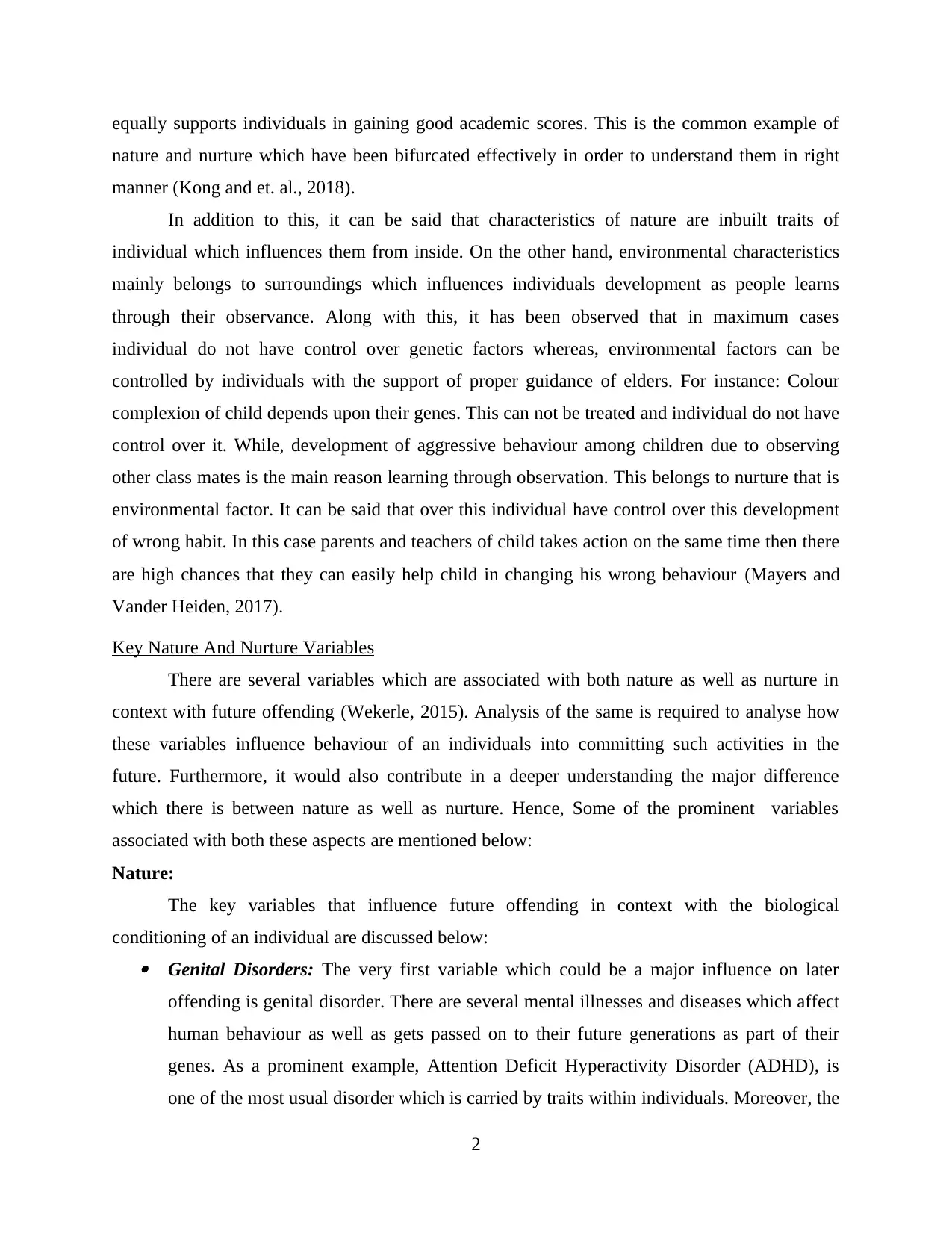
equally supports individuals in gaining good academic scores. This is the common example of
nature and nurture which have been bifurcated effectively in order to understand them in right
manner (Kong and et. al., 2018).
In addition to this, it can be said that characteristics of nature are inbuilt traits of
individual which influences them from inside. On the other hand, environmental characteristics
mainly belongs to surroundings which influences individuals development as people learns
through their observance. Along with this, it has been observed that in maximum cases
individual do not have control over genetic factors whereas, environmental factors can be
controlled by individuals with the support of proper guidance of elders. For instance: Colour
complexion of child depends upon their genes. This can not be treated and individual do not have
control over it. While, development of aggressive behaviour among children due to observing
other class mates is the main reason learning through observation. This belongs to nurture that is
environmental factor. It can be said that over this individual have control over this development
of wrong habit. In this case parents and teachers of child takes action on the same time then there
are high chances that they can easily help child in changing his wrong behaviour (Mayers and
Vander Heiden, 2017).
Key Nature And Nurture Variables
There are several variables which are associated with both nature as well as nurture in
context with future offending (Wekerle, 2015). Analysis of the same is required to analyse how
these variables influence behaviour of an individuals into committing such activities in the
future. Furthermore, it would also contribute in a deeper understanding the major difference
which there is between nature as well as nurture. Hence, Some of the prominent variables
associated with both these aspects are mentioned below:
Nature:
The key variables that influence future offending in context with the biological
conditioning of an individual are discussed below: Genital Disorders: The very first variable which could be a major influence on later
offending is genital disorder. There are several mental illnesses and diseases which affect
human behaviour as well as gets passed on to their future generations as part of their
genes. As a prominent example, Attention Deficit Hyperactivity Disorder (ADHD), is
one of the most usual disorder which is carried by traits within individuals. Moreover, the
2
nature and nurture which have been bifurcated effectively in order to understand them in right
manner (Kong and et. al., 2018).
In addition to this, it can be said that characteristics of nature are inbuilt traits of
individual which influences them from inside. On the other hand, environmental characteristics
mainly belongs to surroundings which influences individuals development as people learns
through their observance. Along with this, it has been observed that in maximum cases
individual do not have control over genetic factors whereas, environmental factors can be
controlled by individuals with the support of proper guidance of elders. For instance: Colour
complexion of child depends upon their genes. This can not be treated and individual do not have
control over it. While, development of aggressive behaviour among children due to observing
other class mates is the main reason learning through observation. This belongs to nurture that is
environmental factor. It can be said that over this individual have control over this development
of wrong habit. In this case parents and teachers of child takes action on the same time then there
are high chances that they can easily help child in changing his wrong behaviour (Mayers and
Vander Heiden, 2017).
Key Nature And Nurture Variables
There are several variables which are associated with both nature as well as nurture in
context with future offending (Wekerle, 2015). Analysis of the same is required to analyse how
these variables influence behaviour of an individuals into committing such activities in the
future. Furthermore, it would also contribute in a deeper understanding the major difference
which there is between nature as well as nurture. Hence, Some of the prominent variables
associated with both these aspects are mentioned below:
Nature:
The key variables that influence future offending in context with the biological
conditioning of an individual are discussed below: Genital Disorders: The very first variable which could be a major influence on later
offending is genital disorder. There are several mental illnesses and diseases which affect
human behaviour as well as gets passed on to their future generations as part of their
genes. As a prominent example, Attention Deficit Hyperactivity Disorder (ADHD), is
one of the most usual disorder which is carried by traits within individuals. Moreover, the
2
Paraphrase This Document
Need a fresh take? Get an instant paraphrase of this document with our AI Paraphraser
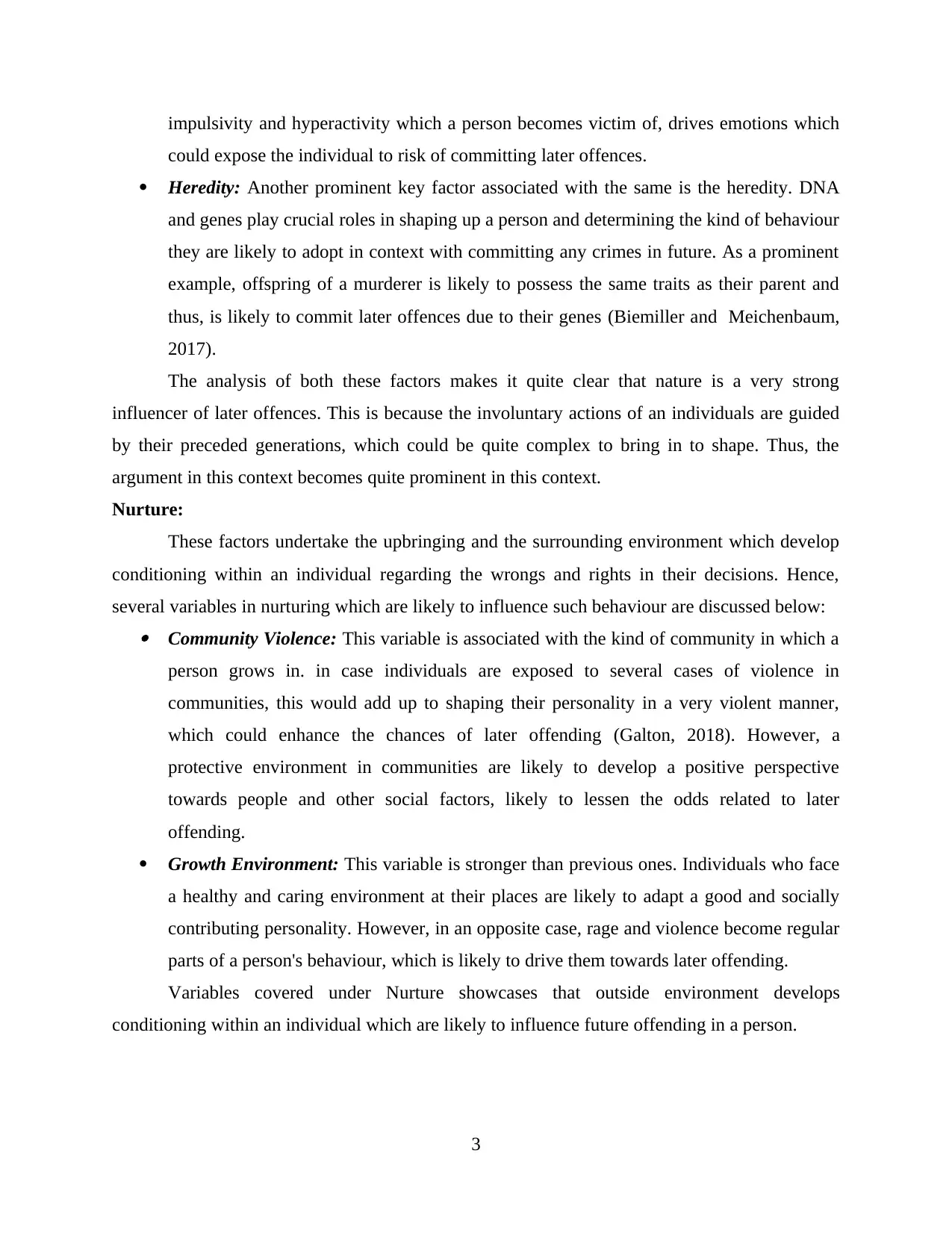
impulsivity and hyperactivity which a person becomes victim of, drives emotions which
could expose the individual to risk of committing later offences.
Heredity: Another prominent key factor associated with the same is the heredity. DNA
and genes play crucial roles in shaping up a person and determining the kind of behaviour
they are likely to adopt in context with committing any crimes in future. As a prominent
example, offspring of a murderer is likely to possess the same traits as their parent and
thus, is likely to commit later offences due to their genes (Biemiller and Meichenbaum,
2017).
The analysis of both these factors makes it quite clear that nature is a very strong
influencer of later offences. This is because the involuntary actions of an individuals are guided
by their preceded generations, which could be quite complex to bring in to shape. Thus, the
argument in this context becomes quite prominent in this context.
Nurture:
These factors undertake the upbringing and the surrounding environment which develop
conditioning within an individual regarding the wrongs and rights in their decisions. Hence,
several variables in nurturing which are likely to influence such behaviour are discussed below: Community Violence: This variable is associated with the kind of community in which a
person grows in. in case individuals are exposed to several cases of violence in
communities, this would add up to shaping their personality in a very violent manner,
which could enhance the chances of later offending (Galton, 2018). However, a
protective environment in communities are likely to develop a positive perspective
towards people and other social factors, likely to lessen the odds related to later
offending.
Growth Environment: This variable is stronger than previous ones. Individuals who face
a healthy and caring environment at their places are likely to adapt a good and socially
contributing personality. However, in an opposite case, rage and violence become regular
parts of a person's behaviour, which is likely to drive them towards later offending.
Variables covered under Nurture showcases that outside environment develops
conditioning within an individual which are likely to influence future offending in a person.
3
could expose the individual to risk of committing later offences.
Heredity: Another prominent key factor associated with the same is the heredity. DNA
and genes play crucial roles in shaping up a person and determining the kind of behaviour
they are likely to adopt in context with committing any crimes in future. As a prominent
example, offspring of a murderer is likely to possess the same traits as their parent and
thus, is likely to commit later offences due to their genes (Biemiller and Meichenbaum,
2017).
The analysis of both these factors makes it quite clear that nature is a very strong
influencer of later offences. This is because the involuntary actions of an individuals are guided
by their preceded generations, which could be quite complex to bring in to shape. Thus, the
argument in this context becomes quite prominent in this context.
Nurture:
These factors undertake the upbringing and the surrounding environment which develop
conditioning within an individual regarding the wrongs and rights in their decisions. Hence,
several variables in nurturing which are likely to influence such behaviour are discussed below: Community Violence: This variable is associated with the kind of community in which a
person grows in. in case individuals are exposed to several cases of violence in
communities, this would add up to shaping their personality in a very violent manner,
which could enhance the chances of later offending (Galton, 2018). However, a
protective environment in communities are likely to develop a positive perspective
towards people and other social factors, likely to lessen the odds related to later
offending.
Growth Environment: This variable is stronger than previous ones. Individuals who face
a healthy and caring environment at their places are likely to adapt a good and socially
contributing personality. However, in an opposite case, rage and violence become regular
parts of a person's behaviour, which is likely to drive them towards later offending.
Variables covered under Nurture showcases that outside environment develops
conditioning within an individual which are likely to influence future offending in a person.
3
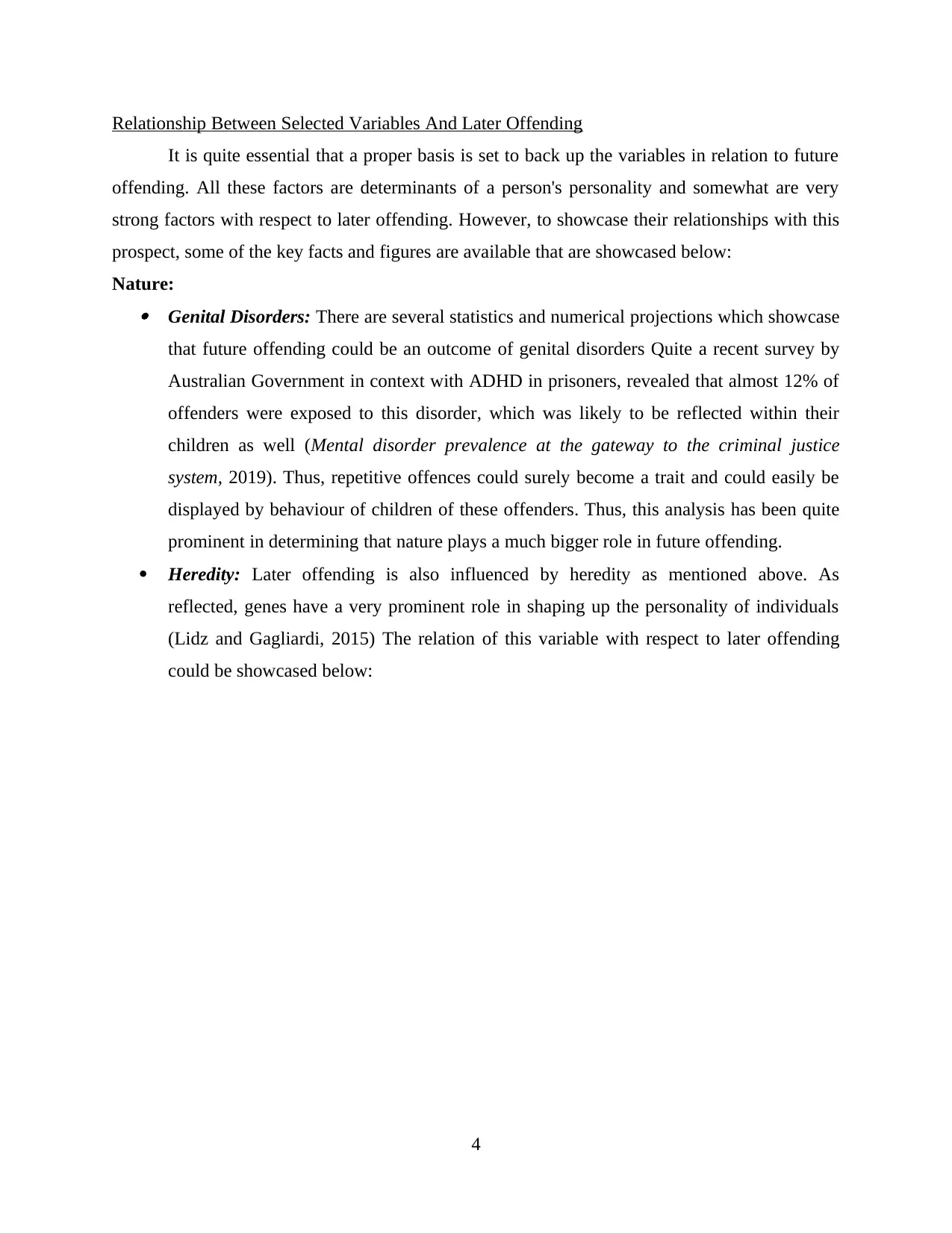
Relationship Between Selected Variables And Later Offending
It is quite essential that a proper basis is set to back up the variables in relation to future
offending. All these factors are determinants of a person's personality and somewhat are very
strong factors with respect to later offending. However, to showcase their relationships with this
prospect, some of the key facts and figures are available that are showcased below:
Nature: Genital Disorders: There are several statistics and numerical projections which showcase
that future offending could be an outcome of genital disorders Quite a recent survey by
Australian Government in context with ADHD in prisoners, revealed that almost 12% of
offenders were exposed to this disorder, which was likely to be reflected within their
children as well (Mental disorder prevalence at the gateway to the criminal justice
system, 2019). Thus, repetitive offences could surely become a trait and could easily be
displayed by behaviour of children of these offenders. Thus, this analysis has been quite
prominent in determining that nature plays a much bigger role in future offending.
Heredity: Later offending is also influenced by heredity as mentioned above. As
reflected, genes have a very prominent role in shaping up the personality of individuals
(Lidz and Gagliardi, 2015) The relation of this variable with respect to later offending
could be showcased below:
4
It is quite essential that a proper basis is set to back up the variables in relation to future
offending. All these factors are determinants of a person's personality and somewhat are very
strong factors with respect to later offending. However, to showcase their relationships with this
prospect, some of the key facts and figures are available that are showcased below:
Nature: Genital Disorders: There are several statistics and numerical projections which showcase
that future offending could be an outcome of genital disorders Quite a recent survey by
Australian Government in context with ADHD in prisoners, revealed that almost 12% of
offenders were exposed to this disorder, which was likely to be reflected within their
children as well (Mental disorder prevalence at the gateway to the criminal justice
system, 2019). Thus, repetitive offences could surely become a trait and could easily be
displayed by behaviour of children of these offenders. Thus, this analysis has been quite
prominent in determining that nature plays a much bigger role in future offending.
Heredity: Later offending is also influenced by heredity as mentioned above. As
reflected, genes have a very prominent role in shaping up the personality of individuals
(Lidz and Gagliardi, 2015) The relation of this variable with respect to later offending
could be showcased below:
4
⊘ This is a preview!⊘
Do you want full access?
Subscribe today to unlock all pages.

Trusted by 1+ million students worldwide
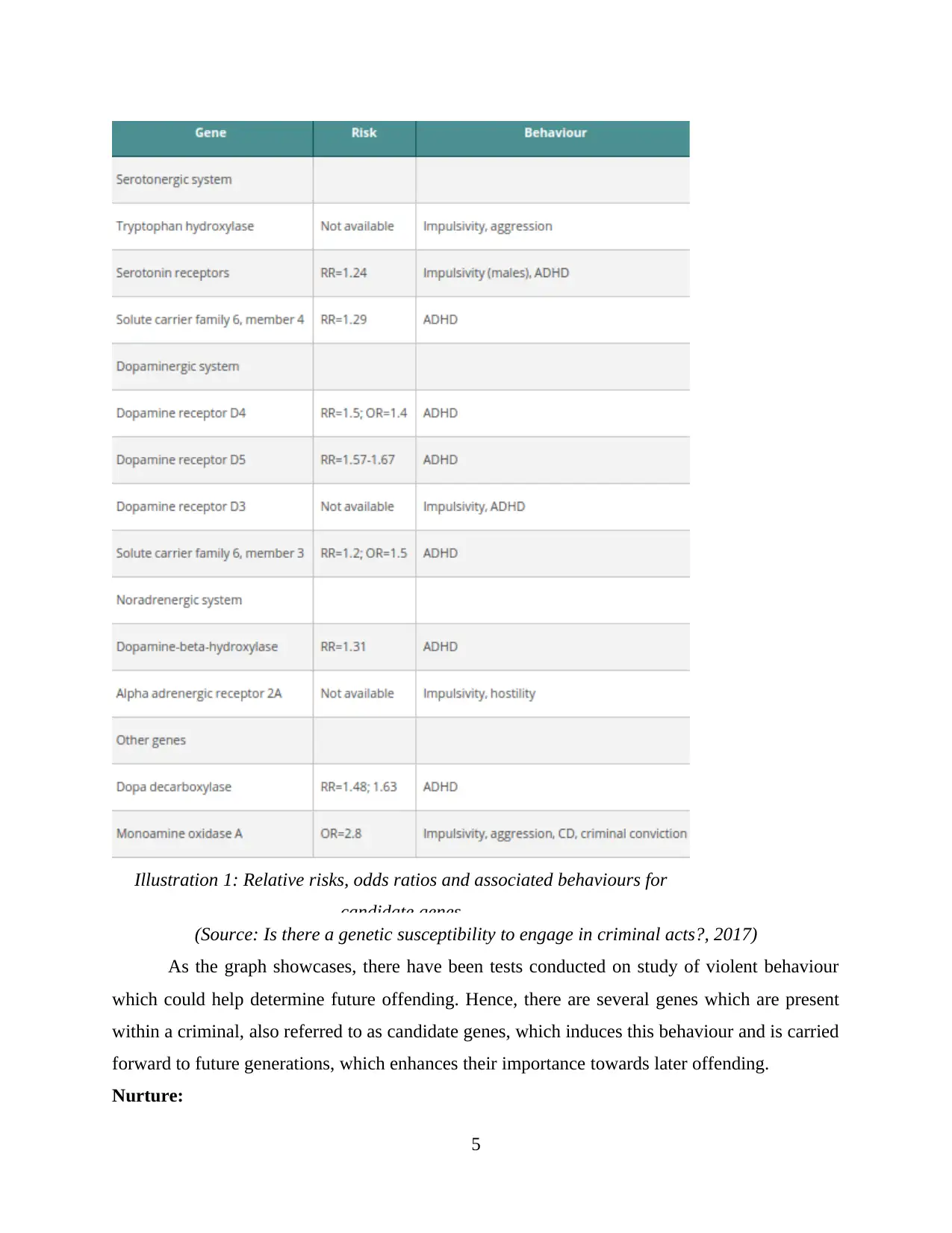
Illustration 1: Relative risks, odds ratios and associated behaviours for
candidate genes
(Source: Is there a genetic susceptibility to engage in criminal acts?, 2017)
As the graph showcases, there have been tests conducted on study of violent behaviour
which could help determine future offending. Hence, there are several genes which are present
within a criminal, also referred to as candidate genes, which induces this behaviour and is carried
forward to future generations, which enhances their importance towards later offending.
Nurture:
5
candidate genes
(Source: Is there a genetic susceptibility to engage in criminal acts?, 2017)
As the graph showcases, there have been tests conducted on study of violent behaviour
which could help determine future offending. Hence, there are several genes which are present
within a criminal, also referred to as candidate genes, which induces this behaviour and is carried
forward to future generations, which enhances their importance towards later offending.
Nurture:
5
Paraphrase This Document
Need a fresh take? Get an instant paraphrase of this document with our AI Paraphraser
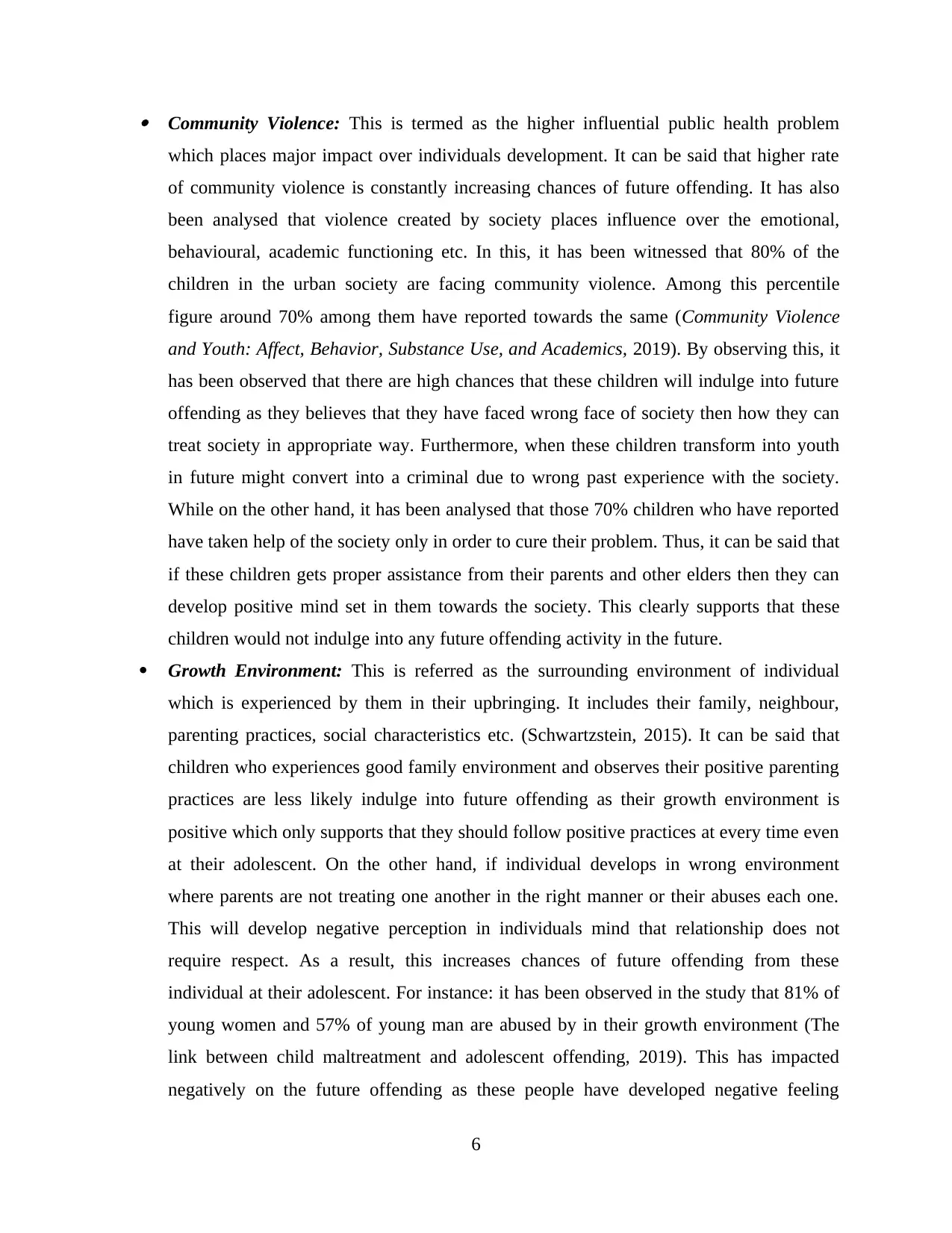
Community Violence: This is termed as the higher influential public health problem
which places major impact over individuals development. It can be said that higher rate
of community violence is constantly increasing chances of future offending. It has also
been analysed that violence created by society places influence over the emotional,
behavioural, academic functioning etc. In this, it has been witnessed that 80% of the
children in the urban society are facing community violence. Among this percentile
figure around 70% among them have reported towards the same (Community Violence
and Youth: Affect, Behavior, Substance Use, and Academics, 2019). By observing this, it
has been observed that there are high chances that these children will indulge into future
offending as they believes that they have faced wrong face of society then how they can
treat society in appropriate way. Furthermore, when these children transform into youth
in future might convert into a criminal due to wrong past experience with the society.
While on the other hand, it has been analysed that those 70% children who have reported
have taken help of the society only in order to cure their problem. Thus, it can be said that
if these children gets proper assistance from their parents and other elders then they can
develop positive mind set in them towards the society. This clearly supports that these
children would not indulge into any future offending activity in the future.
Growth Environment: This is referred as the surrounding environment of individual
which is experienced by them in their upbringing. It includes their family, neighbour,
parenting practices, social characteristics etc. (Schwartzstein, 2015). It can be said that
children who experiences good family environment and observes their positive parenting
practices are less likely indulge into future offending as their growth environment is
positive which only supports that they should follow positive practices at every time even
at their adolescent. On the other hand, if individual develops in wrong environment
where parents are not treating one another in the right manner or their abuses each one.
This will develop negative perception in individuals mind that relationship does not
require respect. As a result, this increases chances of future offending from these
individual at their adolescent. For instance: it has been observed in the study that 81% of
young women and 57% of young man are abused by in their growth environment (The
link between child maltreatment and adolescent offending, 2019). This has impacted
negatively on the future offending as these people have developed negative feeling
6
which places major impact over individuals development. It can be said that higher rate
of community violence is constantly increasing chances of future offending. It has also
been analysed that violence created by society places influence over the emotional,
behavioural, academic functioning etc. In this, it has been witnessed that 80% of the
children in the urban society are facing community violence. Among this percentile
figure around 70% among them have reported towards the same (Community Violence
and Youth: Affect, Behavior, Substance Use, and Academics, 2019). By observing this, it
has been observed that there are high chances that these children will indulge into future
offending as they believes that they have faced wrong face of society then how they can
treat society in appropriate way. Furthermore, when these children transform into youth
in future might convert into a criminal due to wrong past experience with the society.
While on the other hand, it has been analysed that those 70% children who have reported
have taken help of the society only in order to cure their problem. Thus, it can be said that
if these children gets proper assistance from their parents and other elders then they can
develop positive mind set in them towards the society. This clearly supports that these
children would not indulge into any future offending activity in the future.
Growth Environment: This is referred as the surrounding environment of individual
which is experienced by them in their upbringing. It includes their family, neighbour,
parenting practices, social characteristics etc. (Schwartzstein, 2015). It can be said that
children who experiences good family environment and observes their positive parenting
practices are less likely indulge into future offending as their growth environment is
positive which only supports that they should follow positive practices at every time even
at their adolescent. On the other hand, if individual develops in wrong environment
where parents are not treating one another in the right manner or their abuses each one.
This will develop negative perception in individuals mind that relationship does not
require respect. As a result, this increases chances of future offending from these
individual at their adolescent. For instance: it has been observed in the study that 81% of
young women and 57% of young man are abused by in their growth environment (The
link between child maltreatment and adolescent offending, 2019). This has impacted
negatively on the future offending as these people have developed negative feeling
6
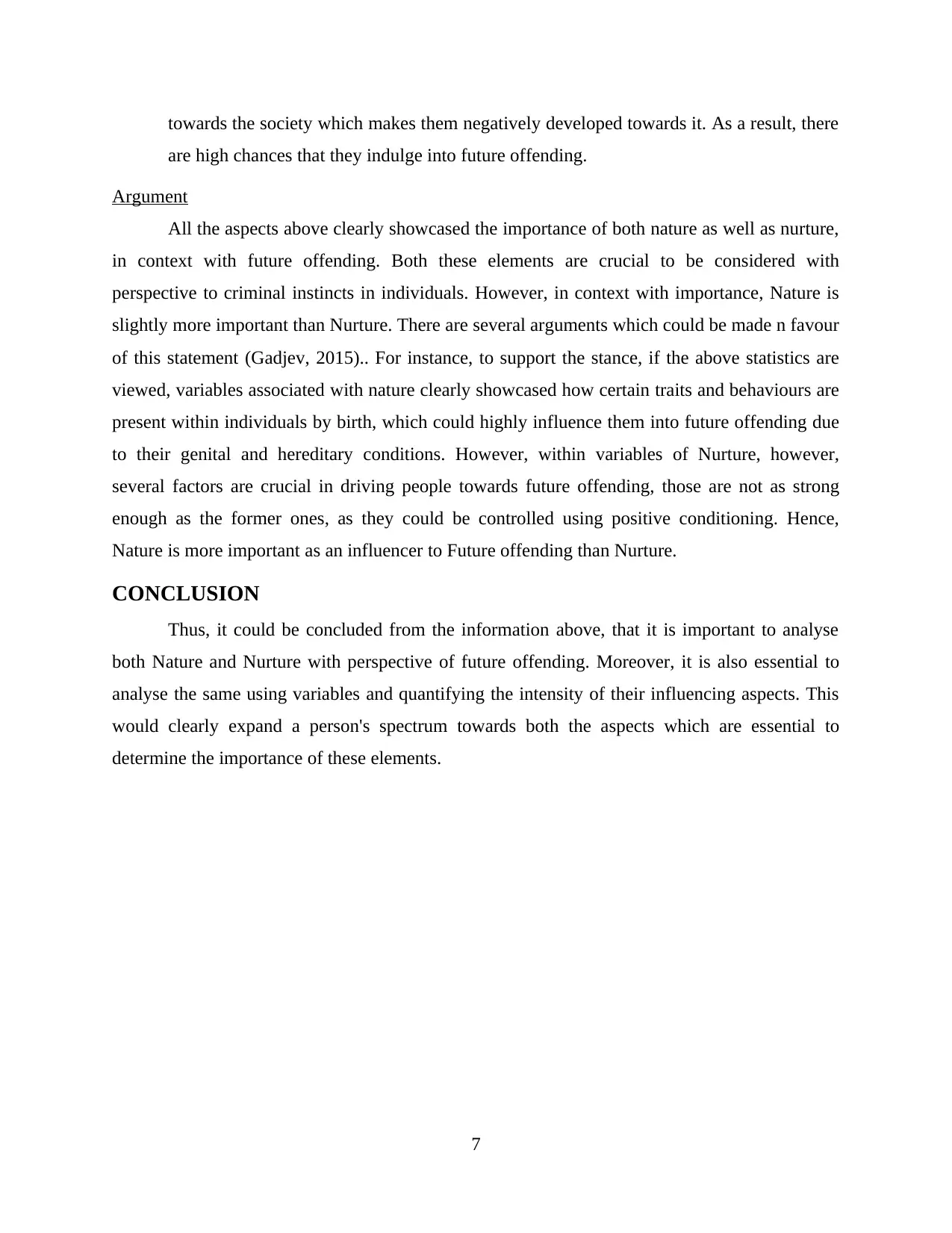
towards the society which makes them negatively developed towards it. As a result, there
are high chances that they indulge into future offending.
Argument
All the aspects above clearly showcased the importance of both nature as well as nurture,
in context with future offending. Both these elements are crucial to be considered with
perspective to criminal instincts in individuals. However, in context with importance, Nature is
slightly more important than Nurture. There are several arguments which could be made n favour
of this statement (Gadjev, 2015).. For instance, to support the stance, if the above statistics are
viewed, variables associated with nature clearly showcased how certain traits and behaviours are
present within individuals by birth, which could highly influence them into future offending due
to their genital and hereditary conditions. However, within variables of Nurture, however,
several factors are crucial in driving people towards future offending, those are not as strong
enough as the former ones, as they could be controlled using positive conditioning. Hence,
Nature is more important as an influencer to Future offending than Nurture.
CONCLUSION
Thus, it could be concluded from the information above, that it is important to analyse
both Nature and Nurture with perspective of future offending. Moreover, it is also essential to
analyse the same using variables and quantifying the intensity of their influencing aspects. This
would clearly expand a person's spectrum towards both the aspects which are essential to
determine the importance of these elements.
7
are high chances that they indulge into future offending.
Argument
All the aspects above clearly showcased the importance of both nature as well as nurture,
in context with future offending. Both these elements are crucial to be considered with
perspective to criminal instincts in individuals. However, in context with importance, Nature is
slightly more important than Nurture. There are several arguments which could be made n favour
of this statement (Gadjev, 2015).. For instance, to support the stance, if the above statistics are
viewed, variables associated with nature clearly showcased how certain traits and behaviours are
present within individuals by birth, which could highly influence them into future offending due
to their genital and hereditary conditions. However, within variables of Nurture, however,
several factors are crucial in driving people towards future offending, those are not as strong
enough as the former ones, as they could be controlled using positive conditioning. Hence,
Nature is more important as an influencer to Future offending than Nurture.
CONCLUSION
Thus, it could be concluded from the information above, that it is important to analyse
both Nature and Nurture with perspective of future offending. Moreover, it is also essential to
analyse the same using variables and quantifying the intensity of their influencing aspects. This
would clearly expand a person's spectrum towards both the aspects which are essential to
determine the importance of these elements.
7
⊘ This is a preview!⊘
Do you want full access?
Subscribe today to unlock all pages.

Trusted by 1+ million students worldwide
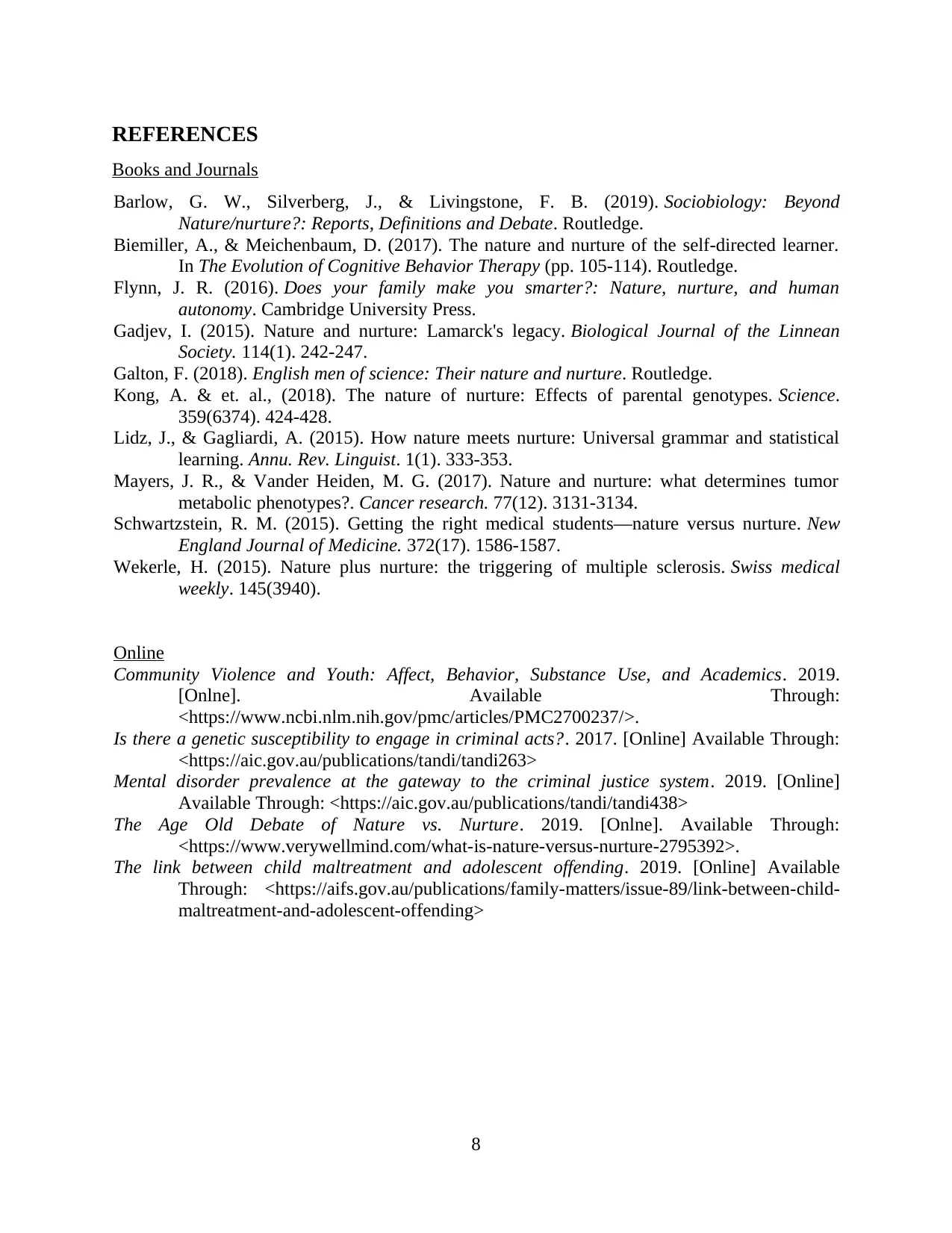
REFERENCES
Books and Journals
Barlow, G. W., Silverberg, J., & Livingstone, F. B. (2019). Sociobiology: Beyond
Nature/nurture?: Reports, Definitions and Debate. Routledge.
Biemiller, A., & Meichenbaum, D. (2017). The nature and nurture of the self-directed learner.
In The Evolution of Cognitive Behavior Therapy (pp. 105-114). Routledge.
Flynn, J. R. (2016). Does your family make you smarter?: Nature, nurture, and human
autonomy. Cambridge University Press.
Gadjev, I. (2015). Nature and nurture: Lamarck's legacy. Biological Journal of the Linnean
Society. 114(1). 242-247.
Galton, F. (2018). English men of science: Their nature and nurture. Routledge.
Kong, A. & et. al., (2018). The nature of nurture: Effects of parental genotypes. Science.
359(6374). 424-428.
Lidz, J., & Gagliardi, A. (2015). How nature meets nurture: Universal grammar and statistical
learning. Annu. Rev. Linguist. 1(1). 333-353.
Mayers, J. R., & Vander Heiden, M. G. (2017). Nature and nurture: what determines tumor
metabolic phenotypes?. Cancer research. 77(12). 3131-3134.
Schwartzstein, R. M. (2015). Getting the right medical students—nature versus nurture. New
England Journal of Medicine. 372(17). 1586-1587.
Wekerle, H. (2015). Nature plus nurture: the triggering of multiple sclerosis. Swiss medical
weekly. 145(3940).
Online
Community Violence and Youth: Affect, Behavior, Substance Use, and Academics. 2019.
[Onlne]. Available Through:
<https://www.ncbi.nlm.nih.gov/pmc/articles/PMC2700237/>.
Is there a genetic susceptibility to engage in criminal acts?. 2017. [Online] Available Through:
<https://aic.gov.au/publications/tandi/tandi263>
Mental disorder prevalence at the gateway to the criminal justice system. 2019. [Online]
Available Through: <https://aic.gov.au/publications/tandi/tandi438>
The Age Old Debate of Nature vs. Nurture. 2019. [Onlne]. Available Through:
<https://www.verywellmind.com/what-is-nature-versus-nurture-2795392>.
The link between child maltreatment and adolescent offending. 2019. [Online] Available
Through: <https://aifs.gov.au/publications/family-matters/issue-89/link-between-child-
maltreatment-and-adolescent-offending>
8
Books and Journals
Barlow, G. W., Silverberg, J., & Livingstone, F. B. (2019). Sociobiology: Beyond
Nature/nurture?: Reports, Definitions and Debate. Routledge.
Biemiller, A., & Meichenbaum, D. (2017). The nature and nurture of the self-directed learner.
In The Evolution of Cognitive Behavior Therapy (pp. 105-114). Routledge.
Flynn, J. R. (2016). Does your family make you smarter?: Nature, nurture, and human
autonomy. Cambridge University Press.
Gadjev, I. (2015). Nature and nurture: Lamarck's legacy. Biological Journal of the Linnean
Society. 114(1). 242-247.
Galton, F. (2018). English men of science: Their nature and nurture. Routledge.
Kong, A. & et. al., (2018). The nature of nurture: Effects of parental genotypes. Science.
359(6374). 424-428.
Lidz, J., & Gagliardi, A. (2015). How nature meets nurture: Universal grammar and statistical
learning. Annu. Rev. Linguist. 1(1). 333-353.
Mayers, J. R., & Vander Heiden, M. G. (2017). Nature and nurture: what determines tumor
metabolic phenotypes?. Cancer research. 77(12). 3131-3134.
Schwartzstein, R. M. (2015). Getting the right medical students—nature versus nurture. New
England Journal of Medicine. 372(17). 1586-1587.
Wekerle, H. (2015). Nature plus nurture: the triggering of multiple sclerosis. Swiss medical
weekly. 145(3940).
Online
Community Violence and Youth: Affect, Behavior, Substance Use, and Academics. 2019.
[Onlne]. Available Through:
<https://www.ncbi.nlm.nih.gov/pmc/articles/PMC2700237/>.
Is there a genetic susceptibility to engage in criminal acts?. 2017. [Online] Available Through:
<https://aic.gov.au/publications/tandi/tandi263>
Mental disorder prevalence at the gateway to the criminal justice system. 2019. [Online]
Available Through: <https://aic.gov.au/publications/tandi/tandi438>
The Age Old Debate of Nature vs. Nurture. 2019. [Onlne]. Available Through:
<https://www.verywellmind.com/what-is-nature-versus-nurture-2795392>.
The link between child maltreatment and adolescent offending. 2019. [Online] Available
Through: <https://aifs.gov.au/publications/family-matters/issue-89/link-between-child-
maltreatment-and-adolescent-offending>
8
1 out of 10
Related Documents
Your All-in-One AI-Powered Toolkit for Academic Success.
+13062052269
info@desklib.com
Available 24*7 on WhatsApp / Email
![[object Object]](/_next/static/media/star-bottom.7253800d.svg)
Unlock your academic potential
Copyright © 2020–2025 A2Z Services. All Rights Reserved. Developed and managed by ZUCOL.




